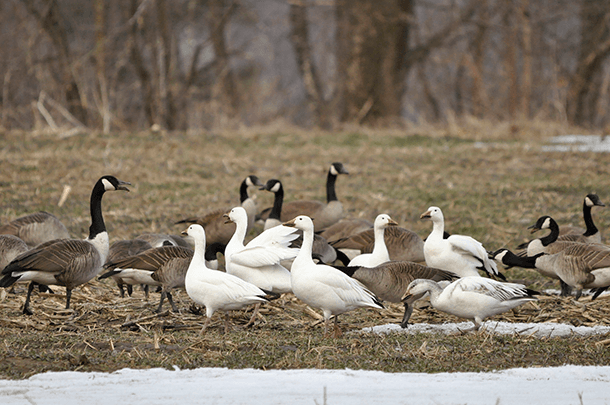Lead-Free Ammunition Saves Waterfowl
CURWOOD: It’s Living on Earth, I’m Steve Curwood.
[MUX – BIRDNOTE THEME]
CURWOOD: Across the globe as the seasons change the vast flyways are thronged with migrating birds. And as Mary McCann explains in this BirdNote, one fall ritual in US marshes and other wetlands is now in the main, less toxic, though not necessarily less deadly.
BirdNote
Waterfowl and Lead
Male Mallard lands in a field. (Photo: Joby Joseph)
[Calls of Canada Geese, Trumpeter Swans, Mallards]
MCCANN: Every autumn, millions of ducks, geese, and swans return south from remote northern breeding grounds to winter in temperate North America.
[Calls of Canada Geese, Trumpeter Swans, Mallards]
MCCANN: And every autumn, the long-standing tradition of waterfowl hunting is reenacted.
[Individual Mallard]
Trumpeter Swan (Photo: Mark Witten)
But one important feature of that hunting tradition has changed. Beginning in 1991, waterfowl hunters were required to switch from lead shotgun pellets to pellets made of non-toxic metals.
In the past, foraging ducks, geese, and swans often ingested lead shot that had fallen to the ground. Waterfowl must swallow hard particles so their gizzards can grind up hard foods, like grains. Unfortunately, they cant tell a lead pellet from a small pebble.
[Male Mallards]
Even two pellets of lead in a ducks digestive system can cause a slow death from the effects of lead poisoning. Many birds were affected. The switch to non-toxic shot has made a positive difference for waterfowl.
Adult and immature Trumpeter Swan forage in a field. (Photo: Jerry McFarland)
[Male Mallards]
But lead shot is still widely used for the hunting of gamebirds like pheasants, which often share areas used by waterfowl.
South Dakota now requires non-toxic pellets for all small game-hunting and even target-shooting. And hunters elsewhere who are concerned about conservation, have made the switch to protect the future of the birds, the habitat, and the tradition they value.
[Calls of Canada Geese and Trumpeter Swans]
Im Mary McCann.
Canada Goose family (Photo: Ken Slade)
###
Written by Bob Sundstrom
Bird audio provided by The Macaulay Library at the Cornell Lab of Ornithology, Ithaca, New York. Canada Goose calls recorded by W.W.H. Gunn. Trumpeter Swan calls recorded by J.M Hawthorne. Mallard calls recorded by A.A. Allen.
Producer: John Kessler
Executive Producer: Dominic Black
2014 Tune In to Nature.org October 2014 Narrator: Mary McCann
http://www.abcbirds.org/abcprograms/policy/toxins/lead-fact-sheet.html
CURWOOD: Youll find photographs of ducks and geese and swans at our website, LOE.org.
The story you just read is accessible and free to all because thousands of listeners and readers contribute to our nonprofit newsroom. We go deep to bring you the human-centered international reporting that you know you can trust. To do this work and to do it well, we rely on the support of our listeners. If you appreciated our coverage this year, if there was a story that made you pause or a song that moved you, would you consider making a gift to sustain our work through 2024 and beyond?
